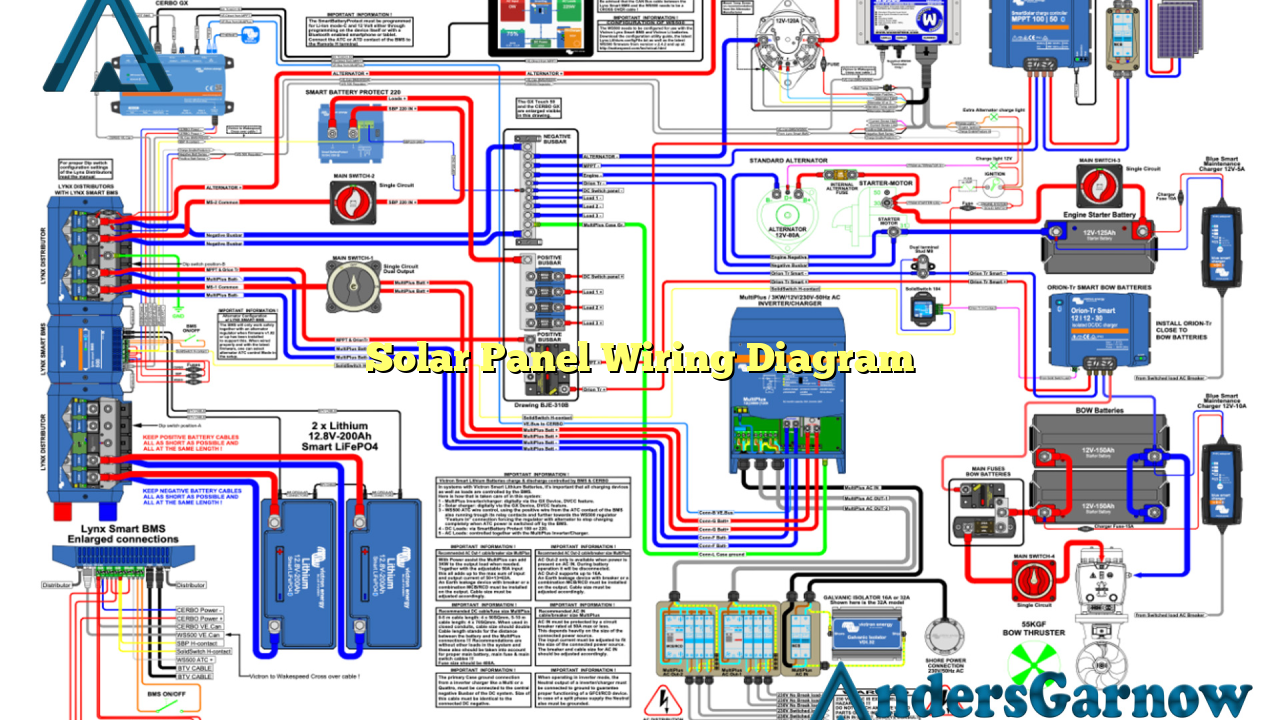Hello, dear readers! In this article, we will delve into the world of solar panel wiring diagrams. Solar panels have become increasingly popular as a sustainable energy source, and understanding how to properly wire them is crucial for their efficient operation. So, let’s get started!
1. Understanding Solar Panel Wiring
Before we dive into the wiring diagram, let’s first understand the basics of solar panel wiring. Solar panels consist of multiple photovoltaic (PV) cells that convert sunlight into electricity. These cells are connected in series or parallel to increase voltage or current, respectively.
The wiring diagram illustrates how these PV cells are connected to form a solar panel array. It shows the flow of electricity from the panels to the charge controller, battery, and inverter, ultimately powering your appliances or feeding excess energy back into the grid.
Advantages of Solar Panel Wiring
There are several advantages to properly wiring your solar panels:
| Advantages | Explanation |
|---|---|
| Maximizes Efficiency | Proper wiring ensures optimal energy transfer, maximizing the efficiency of your solar panels. |
| Prevents Overloading | Correct wiring prevents overloading by regulating the flow of electricity from the panels to the battery and inverter. |
| Easy Troubleshooting | Organized wiring simplifies troubleshooting in case of any issues or malfunctions. |
| Enhanced Safety | Properly wired solar panels reduce the risk of electric shocks and fire hazards. |
2. Series Wiring
Series wiring involves connecting the positive terminal of one solar panel to the negative terminal of the adjacent panel. This configuration increases the total voltage output while maintaining a constant current. However, it is essential to ensure that the panels have the same voltage ratings to avoid power loss.
Advantages of Series Wiring
Series wiring offers the following advantages:
- Higher voltage output for efficient power transmission over long distances.
- Requires fewer wires, reducing installation complexity and costs.
- Allows for expansion by adding more panels to the series.
Disadvantages of Series Wiring
However, there are a few disadvantages to consider:
- If one panel in the series becomes shaded or malfunctions, it affects the performance of the entire array.
- The overall current remains the same as that of a single panel, limiting the power generation capacity.
3. Parallel Wiring
In parallel wiring, all the positive terminals of the solar panels are connected together, and likewise, all the negative terminals are connected together. This configuration increases the total current output while maintaining a constant voltage. It is crucial to use panels with the same current ratings for optimal performance.
Advantages of Parallel Wiring
Parallel wiring offers the following advantages:
- Higher current output for increased power generation capabilities.
- Even if one panel malfunctions or gets shaded, the performance of the other panels remains unaffected.
- Provides flexibility for future expansions by adding more panels in parallel.
Disadvantages of Parallel Wiring
However, there are a few disadvantages to consider:
- Requires more wiring, increasing installation complexity and costs.
- Higher current flow may result in voltage drops, affecting energy efficiency.
4. Combination Wiring
Combination wiring involves both series and parallel connections. This configuration allows for achieving the desired voltage and current requirements by connecting multiple panels in series and then connecting these series strings in parallel.
Advantages of Combination Wiring
Combination wiring offers the benefits of both series and parallel configurations:
- Enables customization of voltage and current output according to specific system requirements.
- Provides flexibility for adjusting the array configuration based on shading or other factors.
Disadvantages of Combination Wiring
However, combination wiring has certain disadvantages:
- Increased complexity in terms of wiring and system design.
- Requires careful planning to ensure balanced voltage and current across the array.
Alternative Solar Panel Wiring Diagram
An alternative solar panel wiring diagram involves the use of microinverters or power optimizers. These devices are installed on each solar panel, allowing for independent power conversion and tracking of performance. This eliminates the need for series or parallel wiring configurations and improves overall system efficiency.
FAQ
Q: Can I mix different types of solar panels in my array?
A: It is generally not recommended to mix different types of solar panels as they may have different voltage and current characteristics, affecting the overall performance of the array.
Q: How do I calculate the required wire size for my solar panel wiring?
A: The wire size depends on the current and length of the wiring. It is crucial to consult local electrical codes and guidelines or seek professional assistance to ensure proper wire sizing.
Q: Can I install solar panels myself?
A: While it is possible to install solar panels yourself, it is recommended to hire a professional installer to ensure safety, compliance with regulations, and optimal system performance.
Conclusion
In conclusion, understanding solar panel wiring diagrams is essential for harnessing the full potential of solar energy. Proper wiring maximizes efficiency, prevents overloading, and ensures safety. Whether you choose series, parallel, or combination wiring, each configuration has its own advantages and disadvantages. Consider your specific requirements and consult professionals to design and install the most suitable wiring system for your solar panel array.

